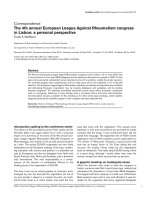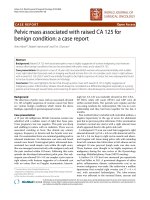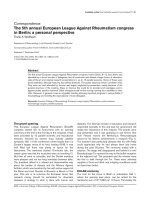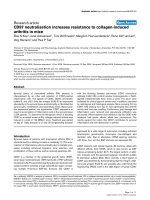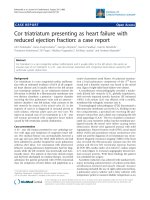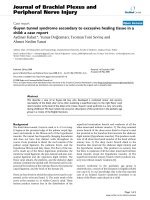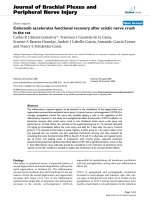Báo cáo y học: " Intraneural injection of corticosteroids to treat nerve damage in leprosy: a case report and review of literature" ppt
Bạn đang xem bản rút gọn của tài liệu. Xem và tải ngay bản đầy đủ của tài liệu tại đây (325.7 KB, 5 trang )
BioMed Central
Page 1 of 5
(page number not for citation purposes)
Journal of Medical Case Reports
Open Access
Case report
Intraneural injection of corticosteroids to treat nerve damage in
leprosy: a case report and review of literature
Sherine G Nashed
1
, Tarek A Rageh
2
, Emad S Attallah-Wasif
3
and Alaa A Abd-
Elsayed*
4
Address:
1
Assiut Dermatology and Leprosy Clinic, Assiut, Egypt,
2
Neurology Department, Assiut University Hospital, Assiut, Egypt,
3
Rush
University Medical Center, Chicago, IL, USA and
4
Public Health and Community Medicine Department, Faculty of Medicine, Assiut University,
Assiut, Egypt
Email: Sherine G Nashed - ; Tarek A Rageh - ; Emad S Attallah-Wasif - emad_attallah-
; Alaa A Abd-Elsayed* -
* Corresponding author
Abstract
Introduction: Nerve damage in leprosy patients leads to deformities and disabilities. Oral
corticosteroids are given early to prevent permanent injury. We present a new approach to treat
well-established nerve damage with local injection of corticosteroids.
Case presentation: A 60-year-old leprosy patient presented with right claw hand deformity
secondary to right ulnar and median neuropathy. Monthly intraneural injection of corticosteroids
resulted in improvement in sensory and motor function of his right hand over a 6-month period.
Nerve conduction velocity testing documented the success of our therapy.
Conclusion: We report the first case of successful nerve regeneration in neglected neuropathy
secondary to leprosy after local injection of corticosteroids. Intraneural extra-fascicular injection
of corticosteroids improved the sensory and motor nerve function in our patient with borderline
leprosy regardless of the duration of nerve function loss.
Introduction
Leprosy is a chronic granulomatous disease caused by
Mycobacterium leprae. It has almost been eliminated from
developed countries but in the developing countries of
Africa, Asia and Latin America, leprosy is still considered
a public health problem. Leprosy is a curable disease and
early treatment will prevent further disabilities [1,2].
Mycobacterium leprae have an affinity for peripheral nerves.
The nerve damage affects sensory, motor, and autonomic
fibers. Sensory loss occurs earliest and is the most fre-
quently affected modality but motor loss can also occur
[3]. The most commonly involved nerves are the posterior
tibial, ulnar, median, lateral popliteal and facial nerves
[4]. Other nerves affected by the disease include the
greater auricular, radial and the radial cutaneous nerves.
Impaired sensation leads to trauma and secondary infec-
tion, which causes tissue damage and deformities. Loss of
motor function produces disability. The end result is
physical impairment.
The immunological response mounted by the host deter-
mines the clinical phenotype of the disease. Tuberculoid
leprosy is the result of a high cell-mediated immune
response. Granulomatous inflammation of the external
fibrous sheath (epineuron) of peripheral nerves trans-
Published: 9 December 2008
Journal of Medical Case Reports 2008, 2:381 doi:10.1186/1752-1947-2-381
Received: 23 April 2008
Accepted: 9 December 2008
This article is available from: />© 2008 Nashed et al; licensee BioMed Central Ltd.
This is an Open Access article distributed under the terms of the Creative Commons Attribution License ( />),
which permits unrestricted use, distribution, and reproduction in any medium, provided the original work is properly cited.
Journal of Medical Case Reports 2008, 2:381 />Page 2 of 5
(page number not for citation purposes)
forms it into a thick cover incapable of stretching under
pressure resulting in nerve damage [5,6]. However, lepro-
matous leprosy is characterized by a humoral immune
response. Lesions are intraneural and extra-fascicular with
bacterial proliferation within the Schwann cells, leading
to foamy degeneration and loss of the ability to regenerate
[7].
Classification of the reactions is essential to determine
therapy and predict prognosis [8]. Type 1 (reversal) reac-
tions occur in tuberculoid disease presenting with acute
inflammation. Acute neuritis results in impairment of
nerve function, which if not treated rapidly, will lead to
permanent damage causing peripheral sensory and motor
neuropathy [9,10]. Type 2 reactions mainly affect leprom-
atous cases with multi-organ involvement [11]. The
greater the infiltration of the skin and the higher the bac-
terial index (BI), the greater the risk of developing type 2
reactions [12].
The treatment of type 1 reactions is aimed at controlling
the acute inflammation, easing pain and reversing nerve
damage. Multi-drug therapy (MDT) should be continued
during a reaction. Acute neuritis is treated early with oral
corticosteroids to minimize nerve damage and thus pre-
vent disability [13]. The majority of type 2 reactions
require immunosuppression. The more severe cases
require high doses of corticosteroids [14]. The recurrent
nature of the condition means that steroid-induced side
effects may become a significant problem.
Corticosteroids have potent anti-inflammatory and anti-
proliferative actions [15]. Intralesional injection of corti-
costeroids has the advantage of achieving a high local con-
centration with no systemic side effects [16]. Our case
presentation shows successful intraneural extra-fascicular
corticosteroid injection in a patient with longstanding
neuropathy secondary to leprosy resulting in nerve regen-
eration.
Case presentation
A 60-year-old right-handed farmer from Upper Egypt was
diagnosed with borderline leprosy in 1985. He finished a
2-year course of MDT (Dapsone, Clofazimine and
Rifampicin) with improvement in his bacteriological
index (BI). However, he was disabled secondary to right
claw hand deformity from neglected nerve damage. He
had no other medical or surgical problems. He had no
known drug allergies and denied alcohol or tobacco con-
sumption.
Neurological evaluation of the right hand revealed com-
plete sensory loss on the palmar surface and 2/5 motor
weakness in conjunction with claw deformity of all fin-
gers. The right ulnar nerve was markedly thickened along
its anatomical course. There was also mild tenderness of
the right median nerve at the wrist level.
Nerve conduction velocity testing (NCV) was performed
on the right ulnar and median nerves. There was no con-
duction detected in the right ulnar nerve while the right
median nerve showed a conduction velocity of 37 m/s.
The sensory nerve conduction study for both nerves
revealed complete absence of any sensory conduction
(Figure 1).
After reviewing the risks and benefits, the patient con-
sented to local corticosteroid injection of the right ulnar
and median nerves. Monthly injection of 4 mg/ml dexam-
ethasone phosphate was carried out for each nerve in the
outpatient clinic for six consecutive months. After appro-
priate skin sterilization with alcohol pads, a 23-gauge nee-
dle was used to inject the ulnar nerve behind the right
medial epicondyle and the median nerve at the palmer
aspect of the right wrist as it enters the carpal tunnel. Pre-
medication with a 20 mg intramuscular injection of bella-
donna extract was performed for prevention of vagal over-
stimulation. There were no complications from the proce-
dure. Serial monthly examination showed recovery of
pain and deep pressure sensation over the hypothenar
eminence that gradually extended to the fingers over the
subsequent course of the therapy. Improvement of light
touch sensation was delayed but eventually progressed in
a similar fashion.
NCV testing was repeated at the end of the treatment
course. There was a marked improvement in the motor
distal latency (DL) and motor conduction velocity (MCV)
of the right median nerve (Figure 2). We were able to
record the compound motor action potential (CMAP) in
the right ulnar nerve. The sensory nerve action potential
(SNAP) for the right ulnar and median nerves was clearly
detected compared to results before the therapy.
Discussion
We report the first case of successful nerve regeneration in
neglected neuropathy secondary to leprosy after local
injection of corticosteroids. Intraneuronal extra-fascicular
injection of corticosteroids reverses the inflammatory and
proliferative response to Mycobacterium leprae. This results
in less mechanical pressure on the neuronal axons facili-
tating nerve regeneration and re-myelination. Our patient
showed improvement in both the sensory and motor
functions of those nerves. There were no reported compli-
cations or side effects from our approach. The advantage
of local corticosteroid therapy is to deliver the medication
at the site of action in a higher concentration compared to
the oral route with minimal systemic side effects.
Journal of Medical Case Reports 2008, 2:381 />Page 3 of 5
(page number not for citation purposes)
Our patient had right claw hand secondary to right ulnar
and median nerve damage. He developed muscle weak-
ness and contractures causing deformity and disability.
Physical therapy with passive and active exercises was
started to prevent fixation of joints. Muscle transplanta-
tion and tendon transfer may be appropriate in some
cases as long as the joints remain mobile [1], however our
patient refused any surgical intervention. Our treatment
provided him with recovery of sensory and motor func-
tion of his right hand thus preventing further deformities.
Use of other therapies including oral thalidomide has
been limited because of teratogenicity (phocomelia) and
possible neurotoxicity. Clofazimine and pentoxifylline
have both been used in type 2 reactions, but they are less
effective than prednisolone or thalidomide [17,18]. Col-
chicine and chloroquine have also been used with limited
effect. It remains to be seen whether tumor necrosis factor
(TNF) blockade with biological agents will have a role to
play in the management of type 2 reactions.
We are currently expanding our treatment protocol to
present a series of similar cases. Eventually a randomized
controlled study will test our hypothesis and compare it to
other available treatment regimens.
Conclusion
We report the first case of successful nerve regeneration in
neglected neuropathy secondary to leprosy after local
injection of corticosteroids. Intraneural extra-fascicular
injection of corticosteroids improved the sensory and
motor nerve function in our patient with borderline lep-
rosy regardless of the duration of nerve function loss.
Consent
Written informed consent was obtained from the patient
for publication of this case report and any accompanying
Nerve conduction velocity before corticosteroid injectionFigure 1
Nerve conduction velocity before corticosteroid injection.
Journal of Medical Case Reports 2008, 2:381 />Page 4 of 5
(page number not for citation purposes)
images. A copy of the written consent is available for
review by the Editor-in-Chief of this journal.
Competing interests
The authors declare that they have no competing interests.
Authors' contributions
SN participated in the patient diagnosis and management,
TR helped in patient management, ESAW participated in
writing the manuscript, and AAA-E participated in patient
management, follow-up and manuscript writing. All
authors read and approved the final manuscript.
References
1. WHO: Global strategy for further reducing the leprosy bur-
den and sustaining leprosy control activities (2006–2010).
Operational guidelines. Lepr Rev 2006, 77(3):1-50.
2. Lockwood DNJ: Leprosy. In Rook's Textbook of Dermatology Volume
2. 7th edition. Edited by: Burns DA, Breathnach SM, Cox NH, Grif-
fiths CEM. Oxford: Blackwell Publishing; 2004:1-29.
3. Agrawal A, Pandit L, Dalal M, Shetty JP: Neurological manifesta-
tions of Hansen's disease and their management. Clin Neurol
Neurosurg 2005, 107(6):445-454.
4. Croft RP, Richardus JH, Nicholls PG, Smith WC: Nerve function
impairment in leprosy: design, methodology, and intake sta-
tus of a prospective cohort study of 2664 new leprosy cases
in Bangladesh (The Bangladesh Acute Nerve Damage
Study). Lepr Rev 1999, 70:140-159.
5. Charosky CB, Gatti JC, Cardama JE: Neuropathies in Hansen's
disease. Int J Lepr Other Mycobact Dis 1953, 51(4):576-586.
6. Modlin RL: Th1-Th2 paradigm: insights from leprosy. J Invest
Dermatol 1994, 102:828-832.
7. Job CK: Pathology of leprosy. In Leprosy 2nd edition. Edited by:
Hastings RC. Edinburgh: Churchill Livingstone; 1994:193-234.
8. Walker SL, Lockwood DNJ: The clinical and immunological fea-
tures of leprosy. Br Med Bull 2006, 77/78:103-121.
9. van Brakel WH, Khawas IB, Lucas SB: Reactions in leprosy: an epi-
demiological study of 386 patients in West Nepal. Lepr Rev
1994, 65:190-203.
10. Cochrane RG: Neuritis in leprosy. In Leprosy in Theory and Practice
2nd edition. Edited by: Cochrane RG, Davey TF. Bristol: Wright;
1964:410-417.
11. Pocaterra L, Jain S, Reddy R, Muzaffarullah S, Torres O, Suneetha S,
Lockwood DN: Clinical course of erythema nodosum lepro-
sum: an 11-year cohort study in Hyderabad, India. Am J Trop
Med Hyg 2006, 74:868-879.
12. Manandhar R, LeMaster JW, Roche PW: Risk factors for erythema
nodosum leprosum. Int J Lepr Other Mycobact Dis
1999,
67:270-278.
13. van Brakel WH, Khawas IB: Nerve function impairment in lep-
rosy: a clinical and epidemiological study – Part 2. Results of
steroid treatment. Lepr Rev 1996, 67:104-118.
Nerve conduction velocity 6 months after corticosteroid injectionFigure 2
Nerve conduction velocity 6 months after corticosteroid injection.
Publish with BioMed Central and every
scientist can read your work free of charge
"BioMed Central will be the most significant development for
disseminating the results of biomedical researc h in our lifetime."
Sir Paul Nurse, Cancer Research UK
Your research papers will be:
available free of charge to the entire biomedical community
peer reviewed and published immediately upon acceptance
cited in PubMed and archived on PubMed Central
yours — you keep the copyright
Submit your manuscript here:
/>BioMedcentral
Journal of Medical Case Reports 2008, 2:381 />Page 5 of 5
(page number not for citation purposes)
14. Croft RP, Nicholls PG, Steyerberg EW, Richardus JH, Withington SG,
Smith WC: A clinical prediction rule for nerve function
impairment in leprosy patients – revisited after 5 years of fol-
low-up. Lepr Rev 2003, 74:35-41.
15. Rugstad HE: Antiinflammatory and immunoregulatory effects
of glucocorticoids: Mode of action. Scand J Rheumatol 1988,
76(Suppl):257-264.
16. Arndt KA: Manual of Dermatologic Therapeutics: With Essentials of Diag-
nosis 5th edition. Lippincott, Williams and Wilkins; 1995:30.
17. Moreira AL, Kaplan G, Villahermosa LG, Fajardo TJ, Abalos RM, Cel-
lona RV, Balagon MV, Tan EV, Walsh GP: Comparison of pentoxi-
fylline, thalidomide and prednisone in the treatment of ENL.
Int J Lepr Other Mycobact Dis 1998, 66:61-65.
18. WHO: WHO Expert Committee on Leprosy – Fifth Report Technical
Report Series 607. Geneva: World Health Organization; 1977.
